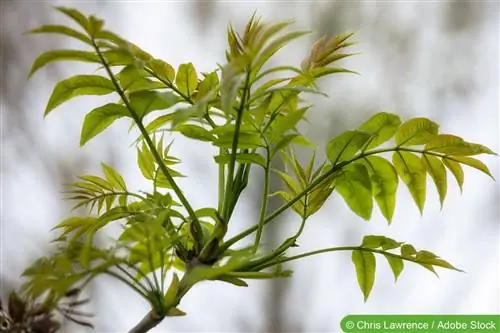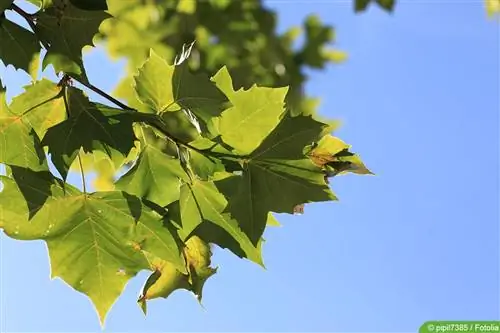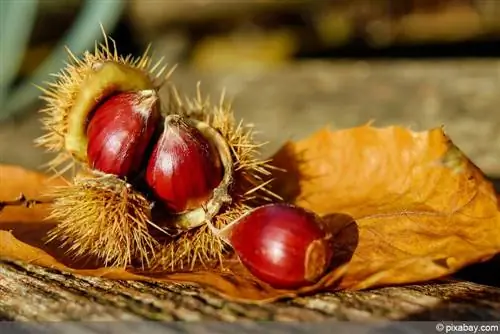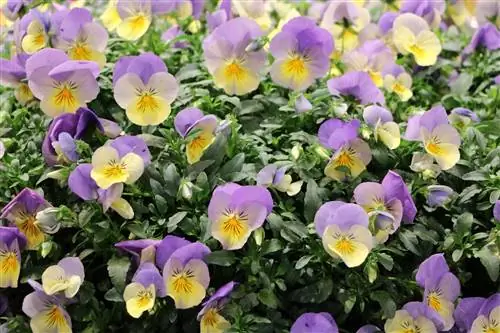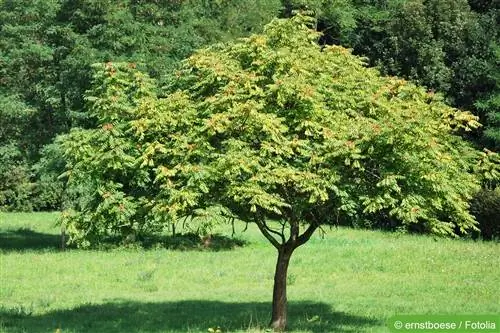- Author admin [email protected].
- Public 2023-12-17 03:39.
- Last modified 2025-01-24 12:45.
The ash is a comparatively easy-care tree that grows quickly in bright locations with sufficient space.
Profile
- Location: bright/sunny; sufficient space
- Soil quality: preferably deep, nutrient-rich subsoil
- Care: water/fertilize if necessary
- Plants: ideally with root balls
- Fungal infestation: remove early if possible
Location
The ash tree benefits from a bright and sunny location. Therefore, the ash is also one of the so-called light tree species in the garden. Although young ash trees generally tolerate shady areas, the latter are unsuitable for the development and growth of the trees. To ensure the full development of an ash tree, its crown should be completely free.
Soil texture
Ash trees prefer cool, mineral and nutrient-rich soil that is able to retain water. Ideally, the subsoil of an ash tree is also well ventilated and not too acidic with an approximate pH value of at least 4. Moisture is generally tolerated by the deciduous tree without any problems. Despite its preference for deep and fresh soil, the ash tree can usually also develop adequately on shallow and dry ground. This makes the ash a very adaptable tree.
Care
Adequate water supply is very important for the growth of an ash tree. The background is that the deciduous tree releases comparatively large amounts of moisture into its surroundings. If an ash tree only has small amounts of water available, it can usually still survive in an appropriate location - however, an insufficient water supply often affects the tree's growth.
If the location is suitable, additional watering of the ash tree is usually only necessary during the first few months after planting. However, during very hot climate periods, it can make sense to regularly check the moisture level of the subsoil of an ash tree. If in doubt, supplementary irrigation should be carried out at short notice.
Although regular fertilization of the ash tree is not absolutely necessary, an additional supply of nutrients can have a positive effect on the growth and he alth of the ash tree. Such fertilization is particularly useful during spring - before the tree flowers, for example, the subsoil can be fertilized every 14 days.
Planting
In order for an ash tree to grow unhindered, it should have sufficient space. This means that an ash tree should not be planted in close proximity to other trees or obstacles such as walls.
When planting a young ash tree, it is recommended to first dig a medium-deep pit at the chosen location. The tree is now placed in the appropriate depression - preferably a tree with a preserved root ball should be selected here. After introduction, the slightly damp root ball is now covered with soil. The soil should then be watered sufficiently. If a young ash tree is planted in areas where frequent wind is expected, it may be useful to support the plant as it begins to grow.
Control and prevention of tree diseases
Basically, the ash is a deciduous tree that is comparatively rarely affected by plant diseases or parasites.
The ash tree is susceptible, for example, to fungal infections such as so-called ash canker - in the early stages, ash canker can be treated, among other things, by professionally cutting out infected parts of the plant. For various fungal diseases, the use of anti-fungal agents (fungicides) such as sulfur preparations is also possible. Agriculture ministries are currently warning of a new fungal infection of ash trees that has spread significantly over the past few years.
In areas known to be affected by fungal diseases of ash trees, the ash trees should be monitored particularly closely - this allows early treatment if necessary. In addition, varieties that have a comparatively high tolerance to damaging fungi can be selected for new planting in appropriate areas.
Interesting facts
The ash tree belongs to the olive tree family and represents around 65 species in the northern hemisphere. The most well-known ash is probably the common ash. All species are deciduous. In spring you can recognize them by their black-brown leaf buds, which are unmistakable. The common ash tree grows to a height of around 40 meters and its trunk diameter can reach around 2 meters. Ash trees that are around 250 years old are not uncommon, provided they are allowed to live that long. The first flowering occurs around the 25th year, the flowering time is May. There are also species that grow particularly narrow; these are often used in cities for street greening.
Use of the wood
The uses of ash trees are very diverse because they are one of the most valuable types of wood. They are particularly hard and are not brittle, which is why ash is particularly suitable for many areas, such as the construction of musical instruments such as violins or guitars. Ash is also a popular type of wood in the sporting goods sector. This is how baseball bats or cues are made from it. Ash trees are even used in shipbuilding. They are the ideal wood for masts or tillers. If ash wasn't so difficult to split, it would produce firewood of the very best quality. Carpenters also like to work with this wood; they describe ash as the finest local wood. Ash is also used in medicine, especially in homeopathy. In the past, many parts of the tree were used as remedies for various diseases. Today the use of homeopathy is limited to tinctures and powders.

